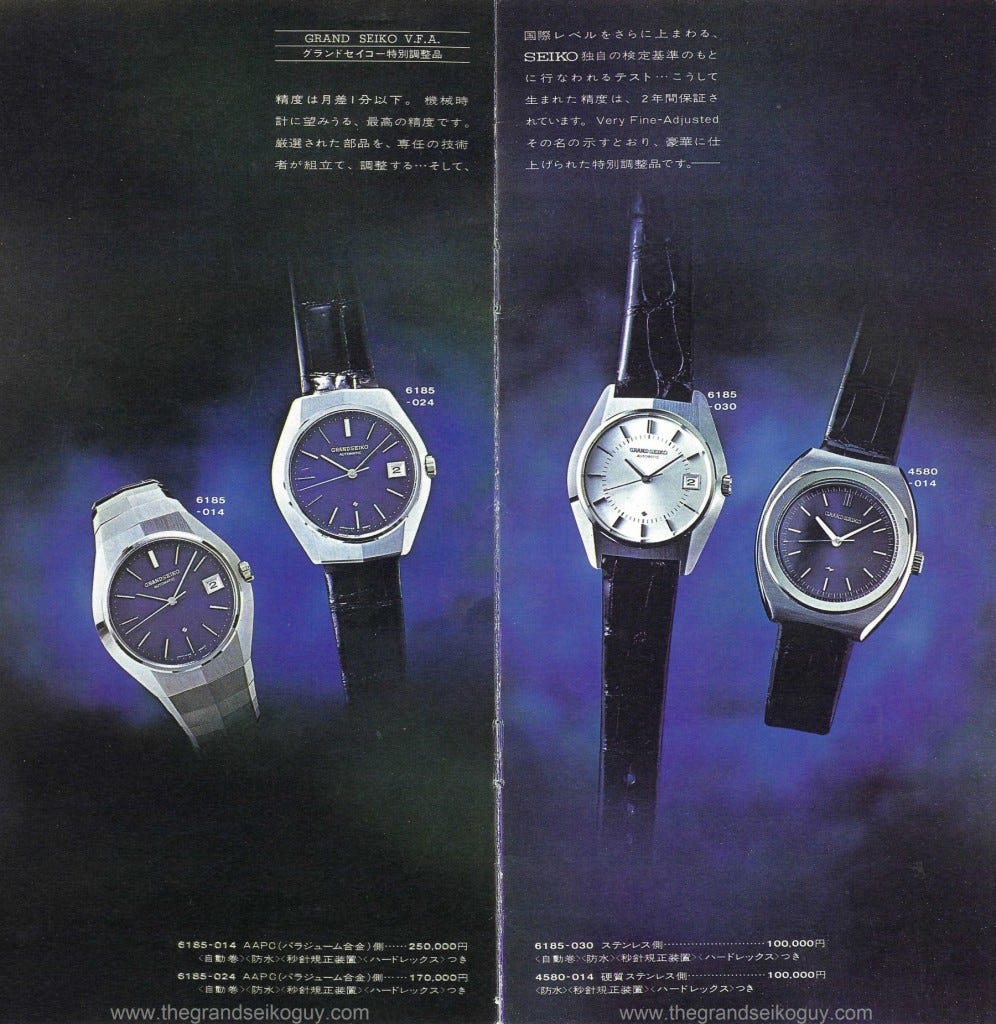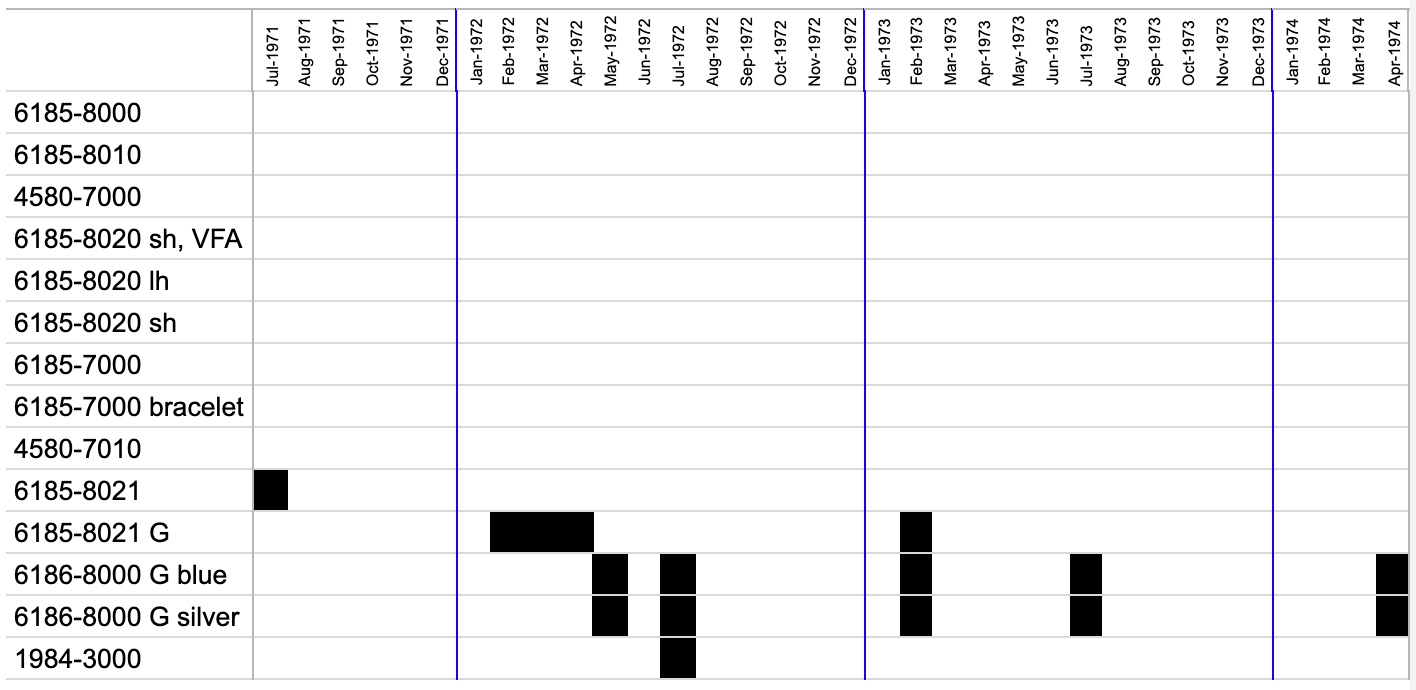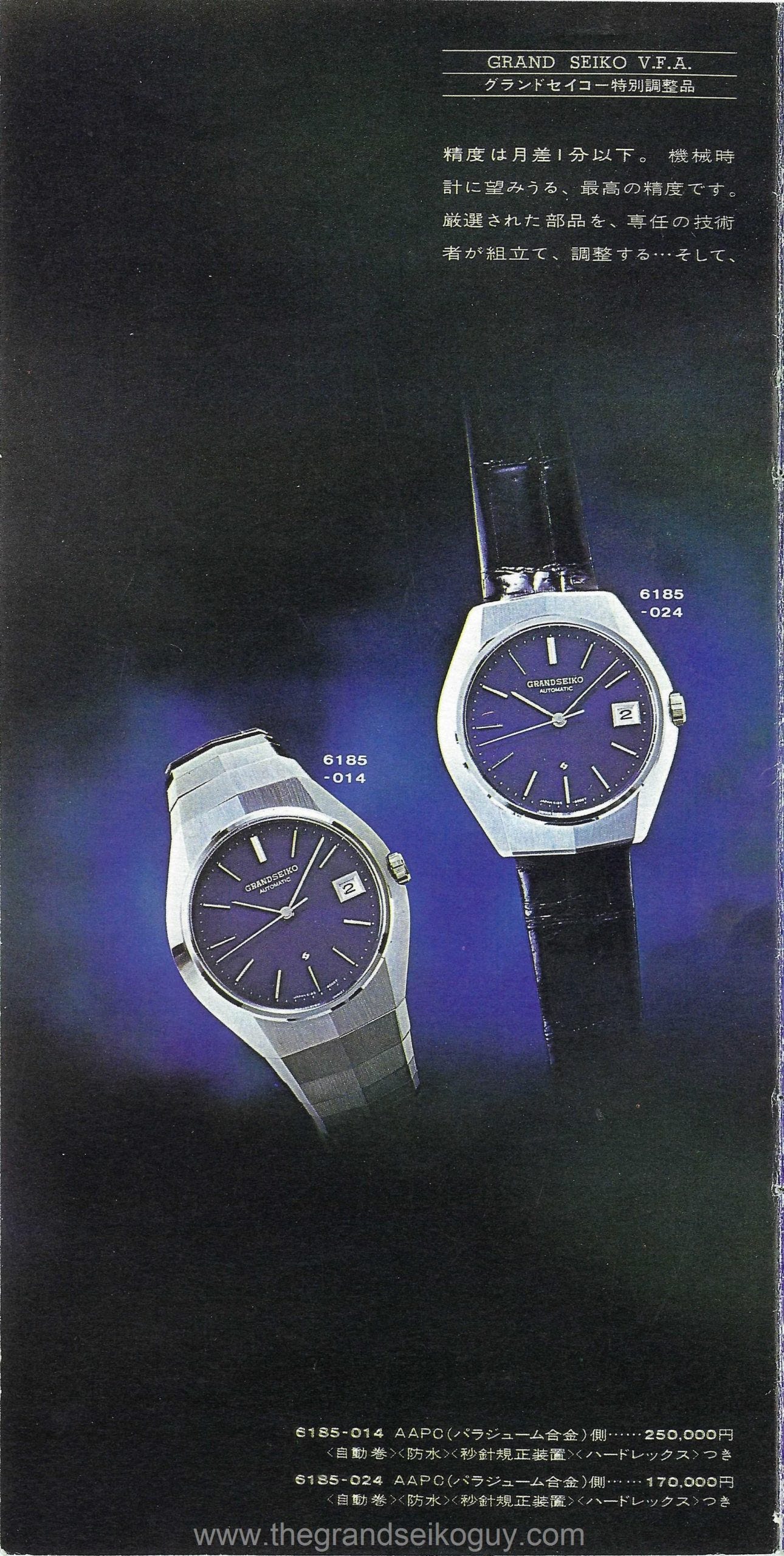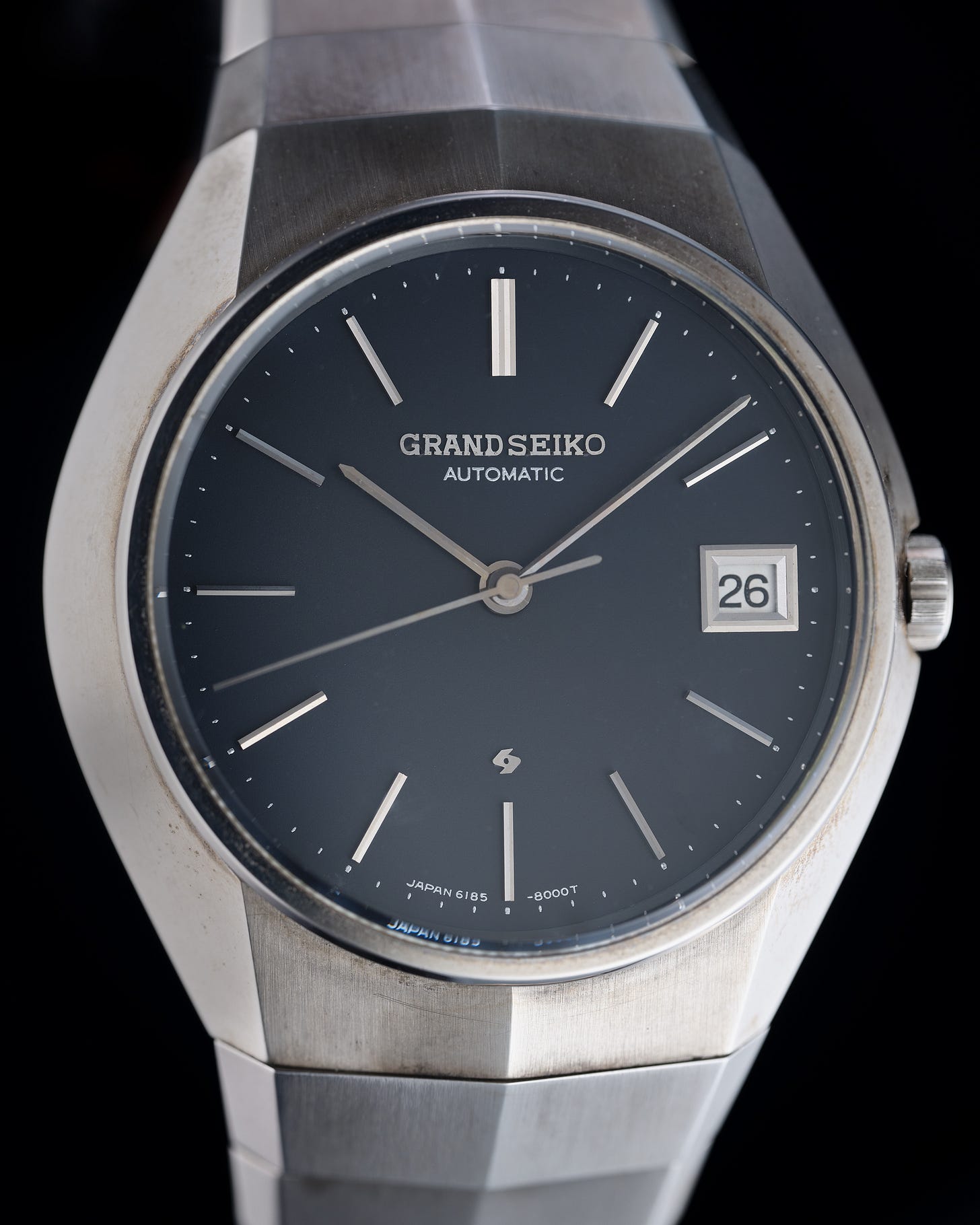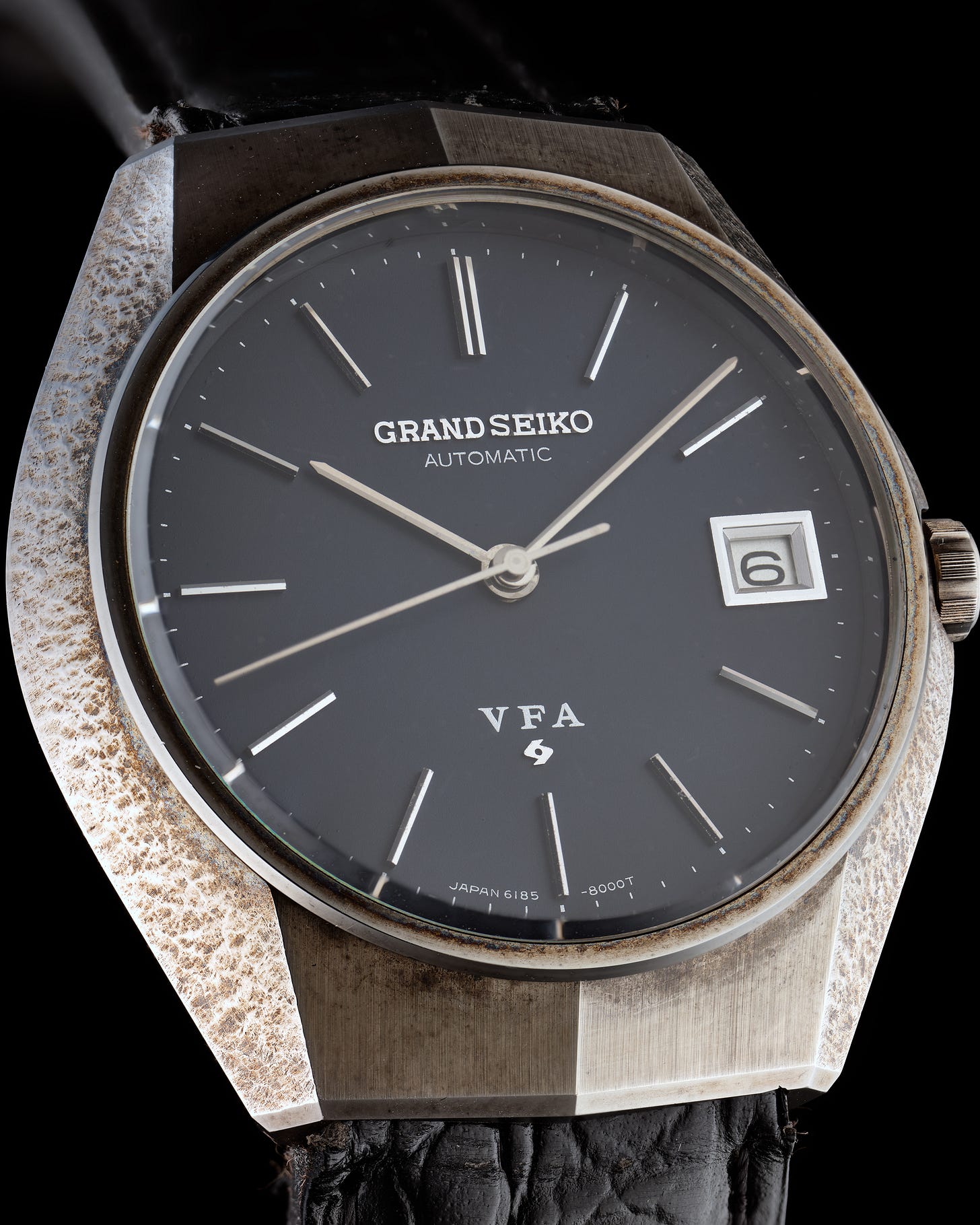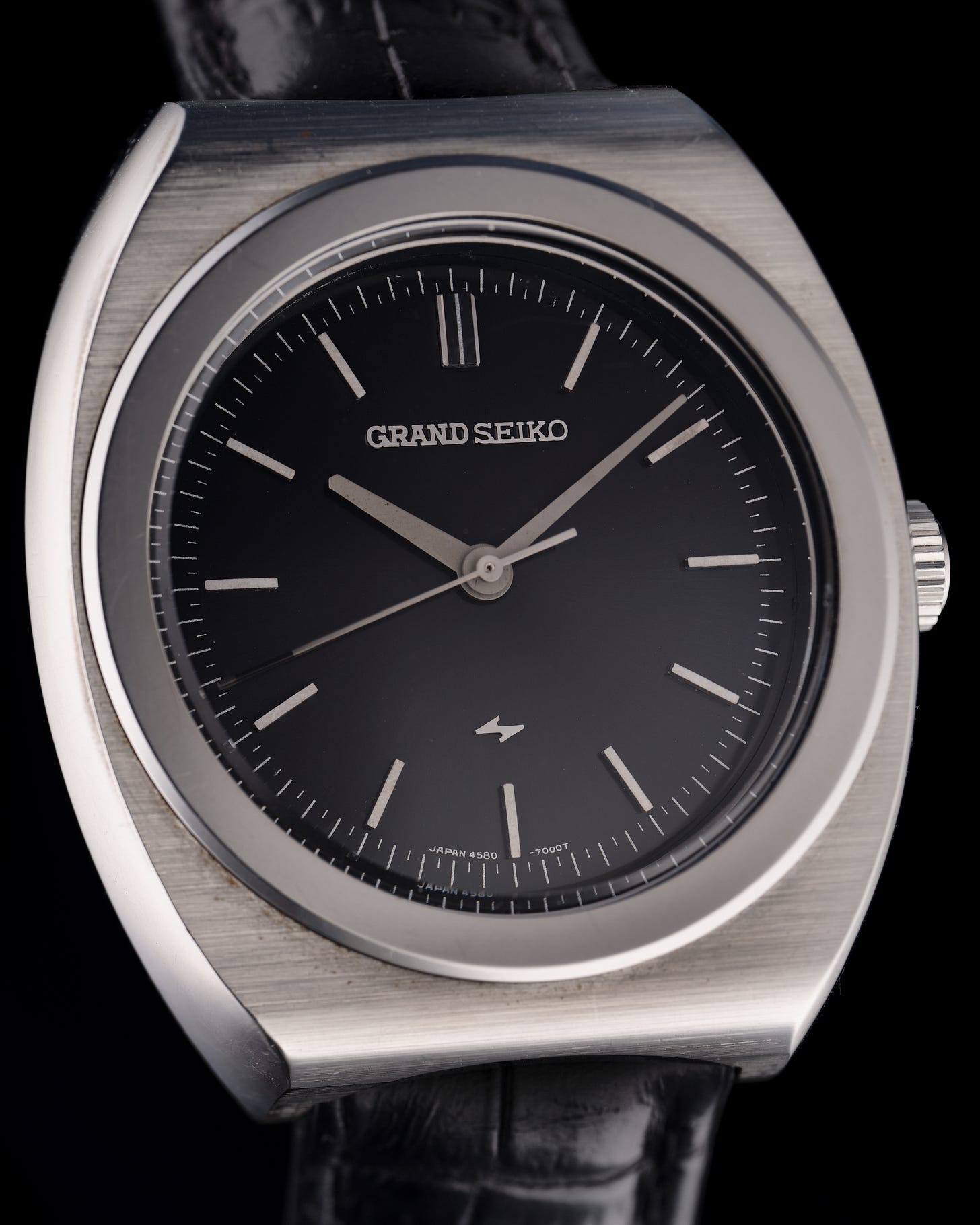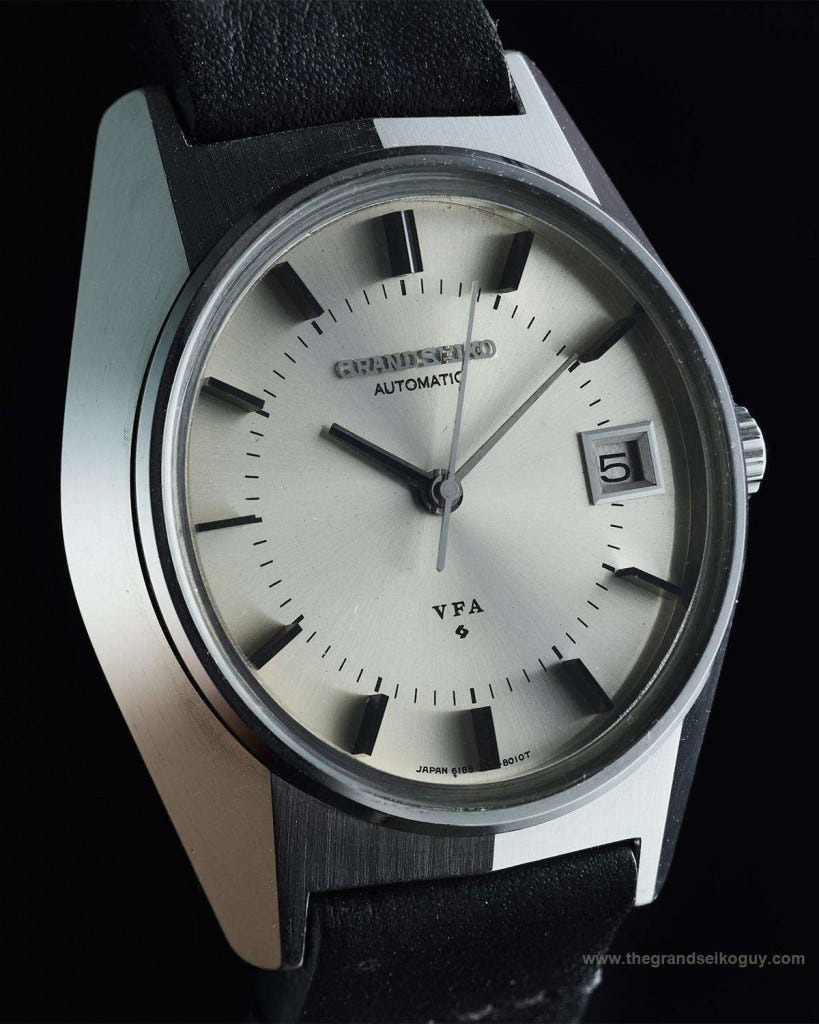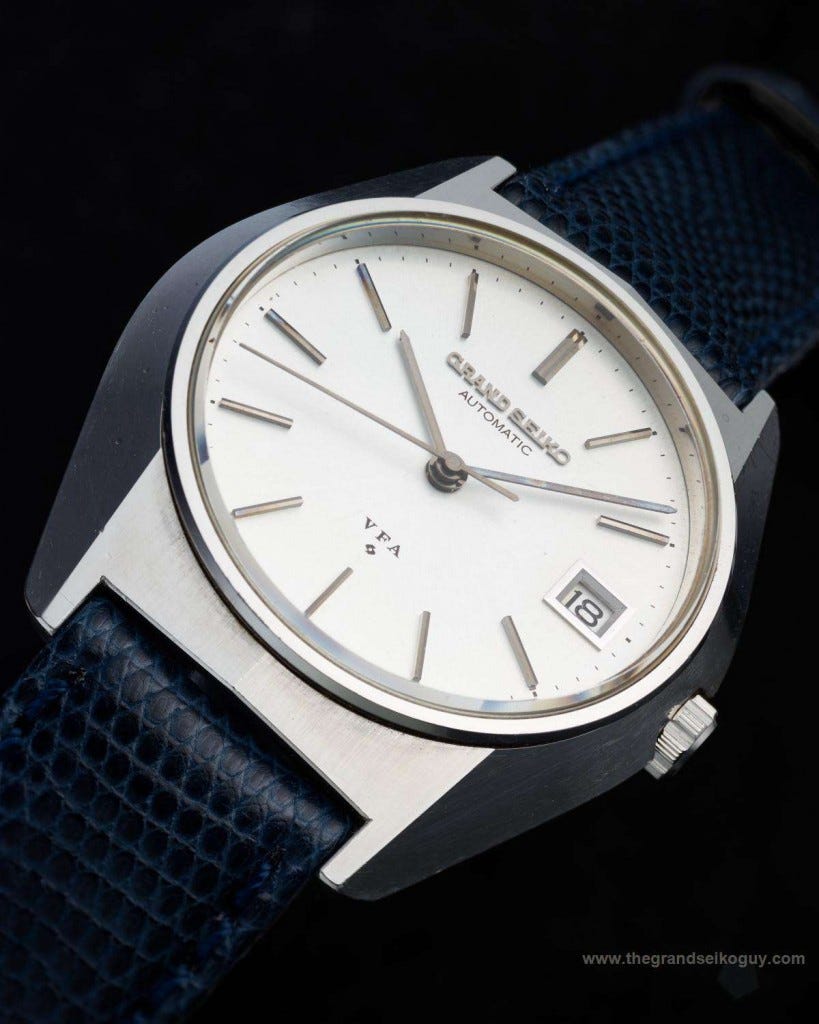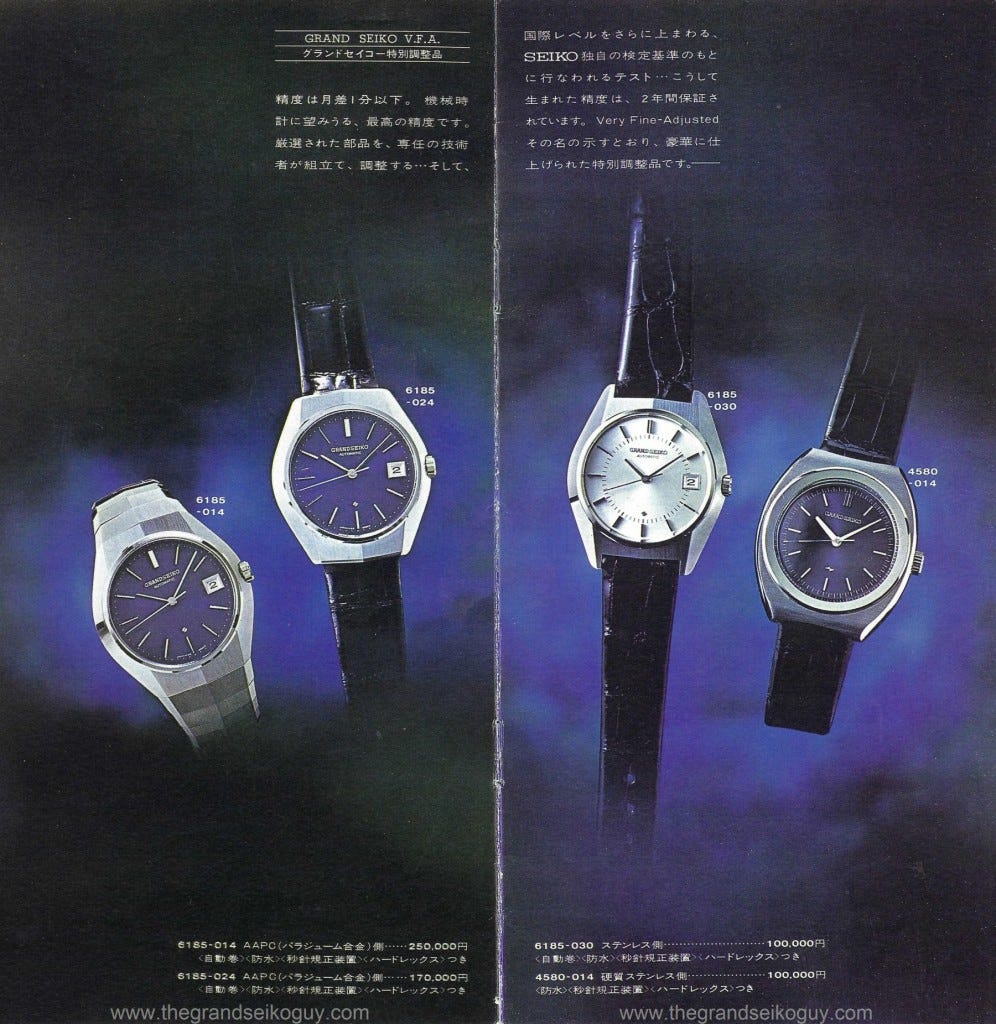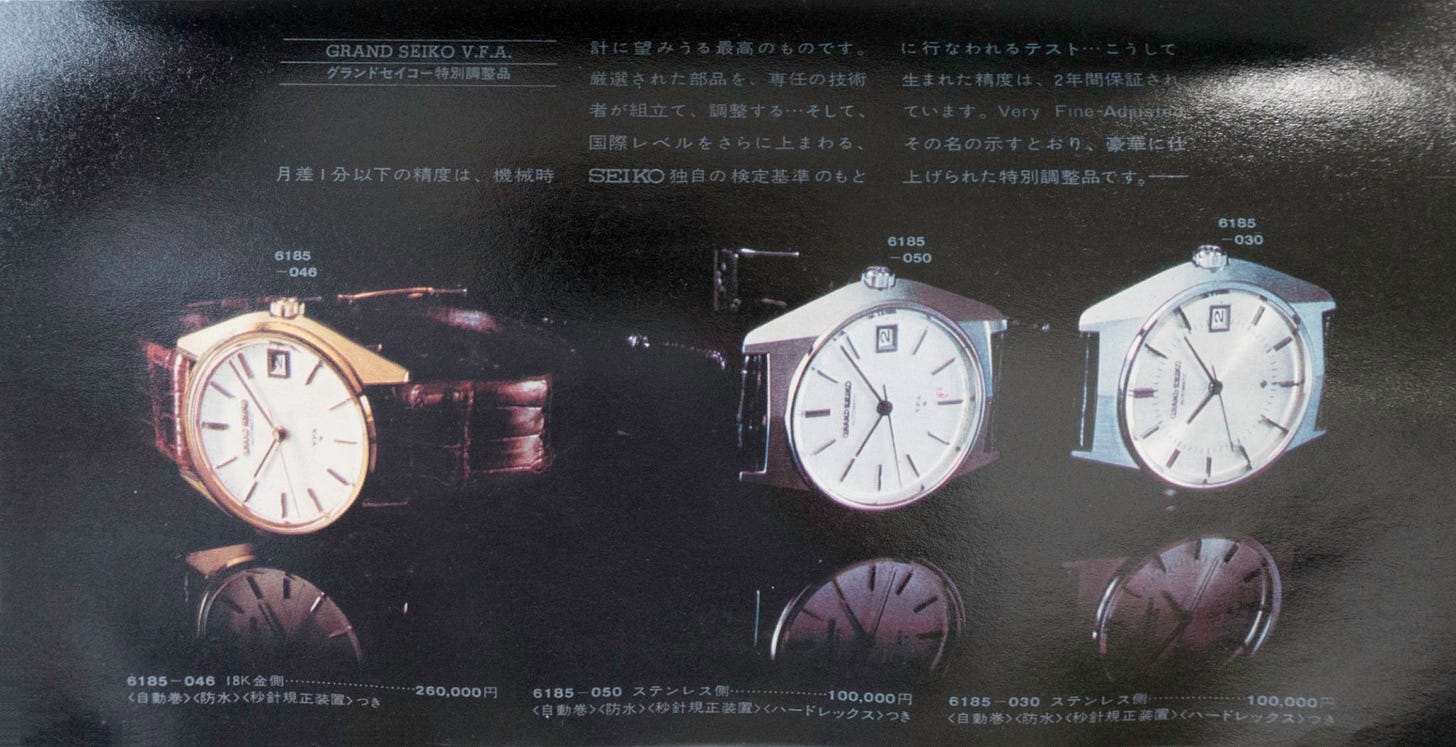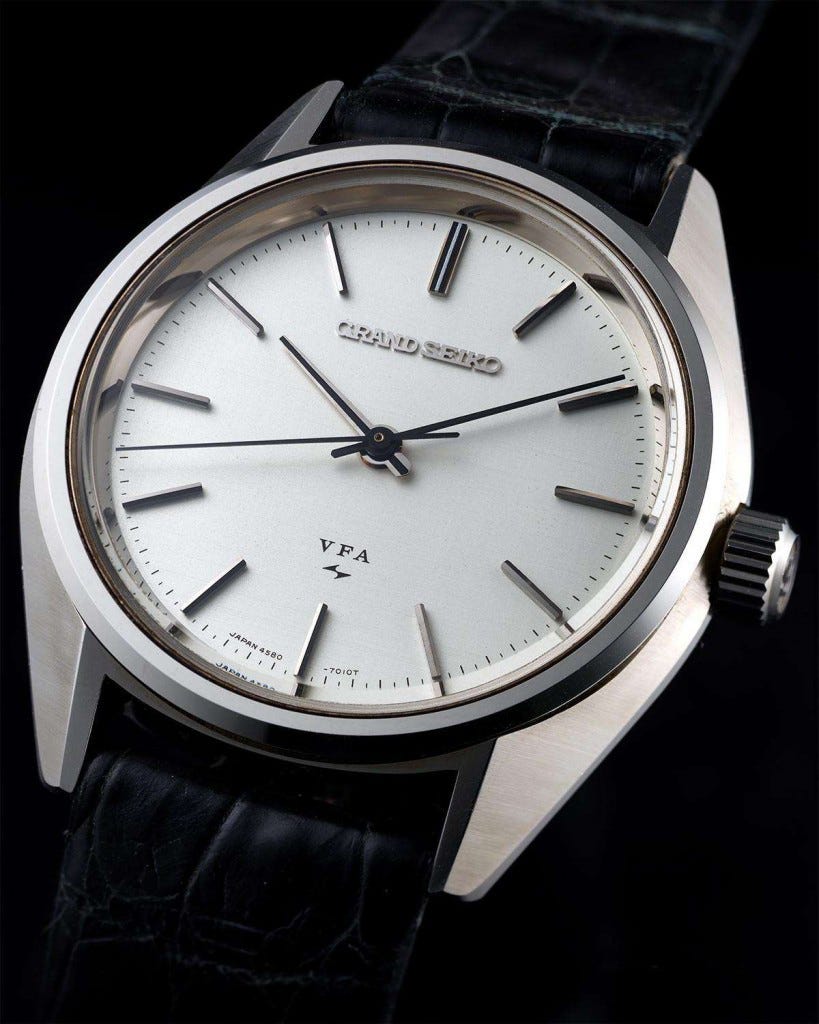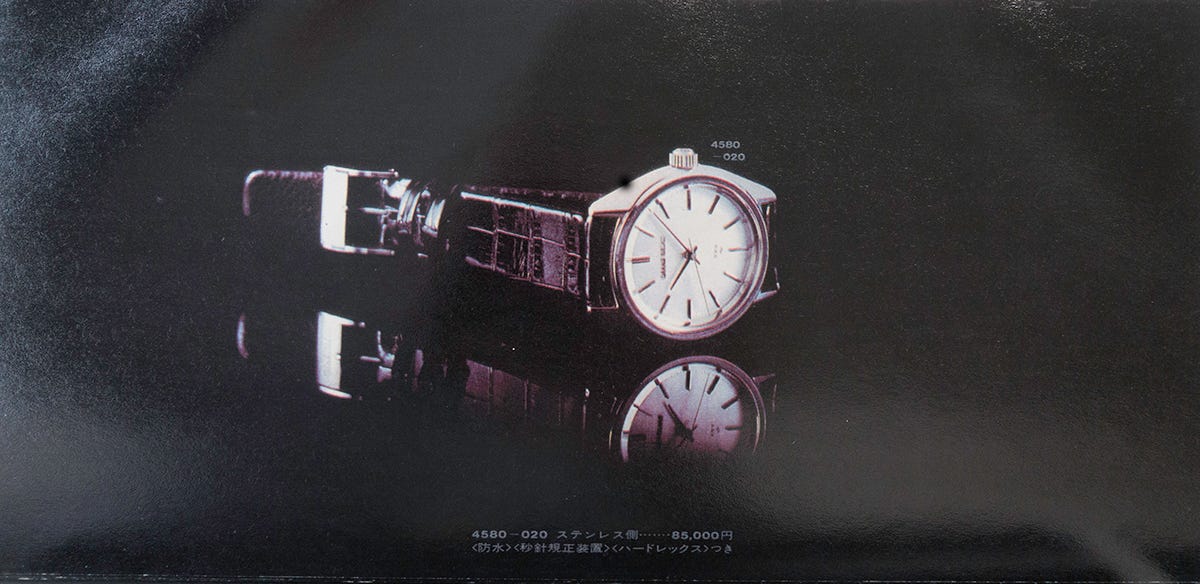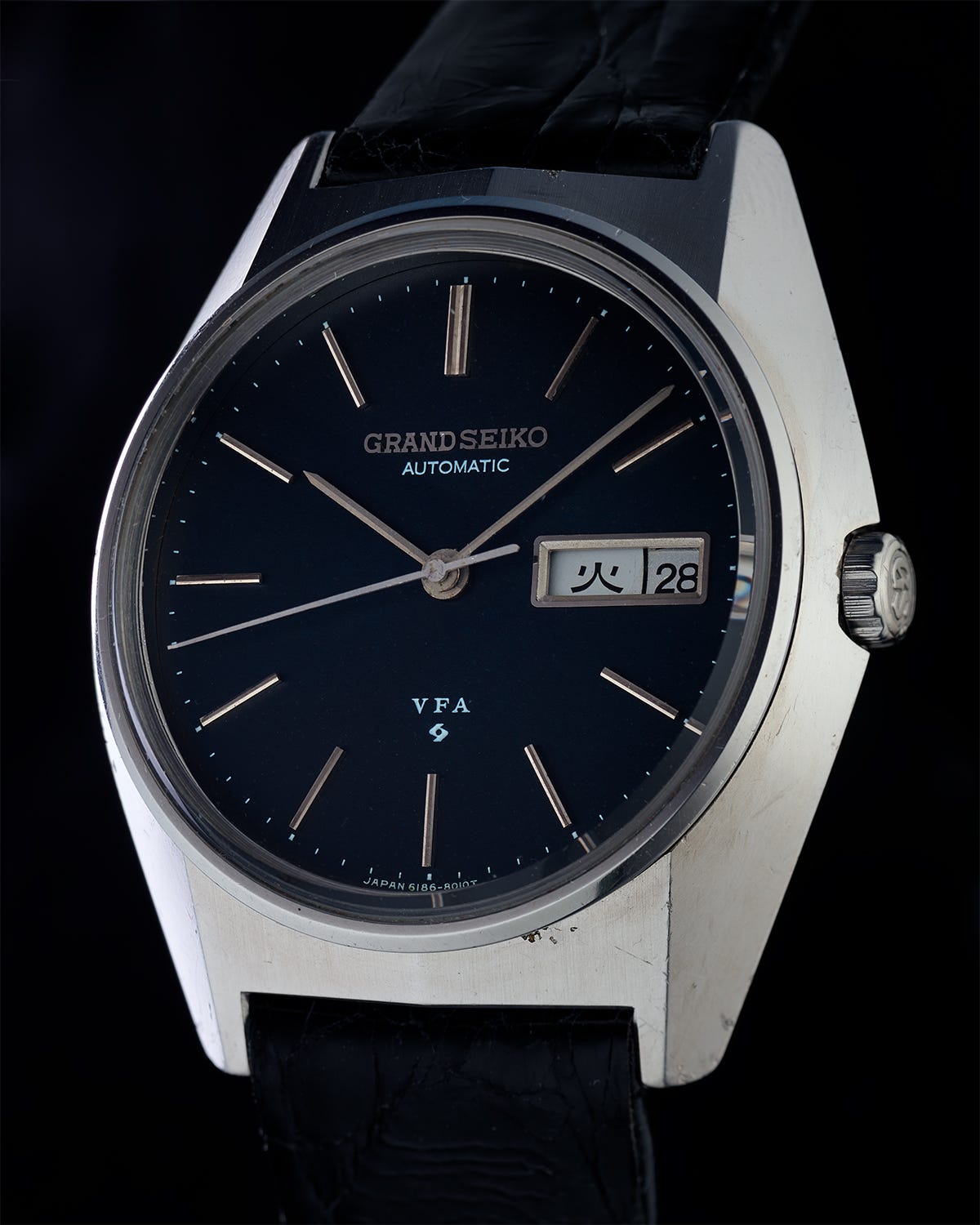Introduction
I was rather surprised to discover the other day that it has been almost five years now since SJX published an article I wrote on the history of the Grand Seiko VFA’s.
Having recently published a primer for collectors on the first Grand Seiko, I thought it might be apposite to take another look at the VFA’s. The benefit of an additional five years of collecting experience, and the ability to examine the last decade’s worth of listings on Yahoo Japan Auctions thanks to my subscribing to an archiving resource, should I believe enable me to pen an update worth perusing.
Rather than simply re-write the original article updating it with what I have learned, I thought it might be more fun to simply start again from scratch.
Let’s see how we get on!
What exactly is a “VFA”?
When the first Grand Seiko was launched in 1960, Seiko’s aim was to prove to the world that they could make a watch every bit as good as the best Switzerland had to offer. Indeed, the headline for the announcement of the watch launch in the March 1961 issue of Seiko News was -
“Challenging Switzerland’s finest domestic products. The finest domestic products.”
One way in which Seiko sought to meet the Swiss head-on was by ensuring their watch was produced to “excellent” chronometer standards, which at that time was defined by the Bureaux Officiels de Contrôle de la Marche des Montres as being accurate to +12/-3 seconds per day.
The story goes that the Swiss were none-too-happy with Seiko testing their own watches in Japan, insisting that no watch deserved to have the word “Chronometer” on its dial unless it had been tested in Switzerland.
With the benefit of hindsight, perhaps this wasn’t the wisest move on behalf of the Swiss - after all, if you tell a company that they are not allowed to use your standards for testing watches, what else do you expect them to do but come up with their own, improved, version?
Thus, by the mid-1960’s, Seiko turned their backs on the Swiss definition of what constituted chronometer-level performance, and came up with their own, eponymous “Grand Seiko Standard”. The Swiss by 1966 had tightened up their standard to a precision of +10/-1 seconds per day. Grand Seiko went three better - their new standard was +5/-3 seconds per day.
But Seiko didn’t stop there. Benefiting from the lessons learned from their participation in the Neufchâtel Chronometry Competitions of the 1960’s, by the end of the decade, both Daini and Suwa were able to launch watches precise to an astonishing +/- 2 seconds per day - and guaranteed to be accurate to 1 minute per month for the first two years of ownership.
These watches were described as being “Very Fine Adjusted”, or “VFA” for short.
VFA production timeline
My original article on the VFA’s that was published by SJX was structured around the appearance of the different VFA references in the Seiko catalogues (both regular, and “Special Luxury”) of the era. For this article I am going to take a different approach.
As I did for the article on the first Grand Seiko -
- I have for the purposes of this newsletter researched examples of the watches that have come up for sale over the last decade, in order to establish a production timeline for the VFA’s. This study has resulted in a database containing details of over 200 watches, more than 75% of which I have been able to ascertain the production month of the watch from the first two characters of the caseback serial number.
It is this real-world data that has led to a deeper understanding of the history of the VFA’s than I had before, and there are some very interesting nuggets of information to be gleaned.
I will (broadly) be presenting the VFA’s in this article based on the order of their first production, and not their catalogue appearances.
Below is a graphic showing the production dates for the VFA’s that I have been able to track down - this comprises data from the ~150 watches where the case serial (or at least the first two characters of it) was visible.
Ok, so that may be a little too small on mobile, so for ease of reading here it is split into two -
Ok let’s break this down by reference or group of references. Firstly, the watches produced in December 1968.
Grand Seiko 6185-8000 and 6185-8010 VFAs
The 6185-8000 is the watch that was featured on the cover of the publication that launched the first four VFA’s - the Seiko Special Luxury Catalogue from 1969. I have written a very detailed article on this catalogue as part of the series of newsletters I published detailing every vintage Grand Seiko reference -
Turning to page 7 of the catalogue, we see the 6185-8010 pictured alongside the 6185-8000.
Both of these watches - with cases (and for the 6185-8000 also its bracelet) manufactured from a palladium-silver alloy - are extraordinarily rare. Following an extensive search I have only managed to track down sales of around a dozen examples across both references - 8 of the 6185-8000, and just 6 of the 6185-8010.
Of these, I have the case serial numbers for 11 of them, and every single one of those was produced in a single month - December 1968.
Whilst there of course could always be the possibility that in time an exception turns up, based on this sample size, I’m fairly confident in stating that the entire production run for these references was from December 1968.
Here’s a studio shot of each reference -
One point of interest regarding both of these references is that examples can be found of each with, and without, VFA printed on the dial. Currently it is not known what the background to these variants is. For quite some time I felt that maybe after the watches had been purchased, customers might have been offered to have VFA printed on the dial at service, but the 6185-8010 example pictured above is in unworn condition, and so it seems very unlikely that it would ever have been sent for a service and “updated”.
In my original article for SJX, I started off by detailing the four watches launched in the 1969 Special Luxury Catalogue, but the research I have done for this article requires me to change that structure, so next up I will discuss just the Daini contribution to the VFA’s debut - the 4580-7000.
Grand Seiko 4580-7000 VFA
The 4580-7000 is a remarkable reference for many reasons, not least because aesthetically there really is no other vintage Grand Seiko quite like it. It’s almost as if Daini set out to create an “anti-Grammar of Design”, and boy did they succeed!
Like the 6185-8000/-8010s that it launched alongside, it is a very rare reference indeed, and I have only been able to track down the sales of 12 examples over the course of the last decade. Of these, the case serial number of 8 are known, with 7 being manufactured in June of 1969, and just one dating from February 1970.
It is a little odd that there is this imbalance in the production. Statistically it is very unlikely to come across such a weighting if production was evenly distributed in those two months. Possibly - and this is pure conjecture on my part - the five 4580 calibre movements originally intended for Seiko Astronomical Observatory Chronometers that failed the tests at Neufchâtel in 1969 ended up being used for this later production run of this reference.
Unlike the aforementioned Suwa 6185 VFA’s, no example of the 4580-7000 with an additional VFA text on the dial has ever been seen.
Grand Seiko 6185-8020 and 6185-8021 VFAs
Ok. So this is where things are going to get a little complicated, and where some new information has come to light as a result of the research undertaken for the purposes of this newsletter. I’m actually going to have to discuss five completely distinct references at this juncture.
Apologies in advance - you may well have to read this section more than once!
Grand Seiko 6185-8020 short hands, VFA on the dial
Grand Seiko 6185-8020 long hands
Grand Seiko 6185-8020 short hands, no VFA on the dial, applied Suwa logo
The last two references (not pictured) in this group are the Grand Seiko 6185-8021, and Grand Seiko 6185-8021-G. Both of these watches look identical (dial side) to the first watch pictured in this section, the 6185-8020 with VFA printed on the dial.
The reason why this bit is complicated is because of what we see in the catalogues, and when.
Here’s the production timeline I shared earlier, but now I will add some boxes to show each reference’s appearance in catalogues.
Here, the red boxes indicate a reference’s appearance in a Special Luxury Catalogue (distributed for the holiday season), and the blue boxes indicate a reference’s appearance in a regular Seiko catalogue (typically published biannually). I have bolded the references that are being referred to in this section.
If you take a moment to get your head around what I’m trying to convey with the timeline graphic, you might spot something very strange.
The first four VFA’s to be pictured in the 1969 Special Luxury Catalogue were the 6185-8000, 6185-8010, 4580-7000 and what I refer to in the graphic as the “6185-8020 sh”, “sh” standing for “short hands”.
Here’s the double page spread showing them all -
What is odd is that there are two references that were in production prior to the short-hand 6185-8020, yet they do not make an appearance in the 1969 Special Luxury Catalogue (“SLC”). In the graphic these references can be identified by “6185-8020 sh, VFA” (for short hands, VFA printed on the dial), and “6185-8020 lh” (for long hands).
The 6185-8020 with the long hands makes its first appearance one year later, in the 1970 Special Luxury Catalogue -
Whereas the 6185 with the short hands, printed Suwa logo and VFA on the dial doesn’t appear until 1972’s regular catalogue -
On writing my original VFA article almost five years ago, I was aware of the existence of a few watches with 6185-8020 casebacks, but with dials having VFA printed on them. I had always considered these to be watches to either have service dials, or be “frankensteined”. As time went on though, I started to get a niggling feeling that perhaps I was seeing more examples of this anomaly than one might expect were my theory to be correct.
Whilst compiling the database for this article, I couldn’t help but notice I was adding more and more examples of VFA’s with 6185-8020 casebacks, but with the dial that I had previously assumed was only correct for the reference that we first see pictured in the 1972 catalogue. Once all the data was in, I counted them up.
To my surprise, I found I had logged the details of no fewer than 19 examples of this variant - a variant that I had always previously assumed could only be explained by a watch having had a dial swapped out at some point.
11 of those 19 watches had visible case serial numbers, and showed production over a wide timeframe, with the earliest dating from July 1969, and the latest March 1971.
With regards to the other references in this section, I have details of just 10 examples of the 6185-8020 with the applied Suwa logo and without the VFA print (as pictured in the 1969 SLC); 29 long handed 6185-8020’s; 20 of the 6185-8021; and 33 of the 6185-8021-G.
Here's a close-up comparison showing the differences between the dials of the 6185-8020 that appears in the 1969 Special Luxury Catalogue (applied Suwa logo, no VFA), and that of the 6185-8020/6185-8021/6185-8021-G that makes its sole appearance in the regular 1972 catalogue (printed VFA and Suwa logo) -
So in summary, if you are after a time and date VFA with the short hands and with VFA printed on the dial, it is by far the most common of all VFA’s that you will see. In fact, no fewer than 35% of all the watches in my database have this dial. You will however find this dial on watches dating from as early as July 1969 right through until February 1973, and with three different caseback codes - 6185-8020, 6185-8021, and 6185-8021-G.
(Note that a watch with this dial only appears in the regular 1972 Seiko catalogue. Since there is no way of knowing exactly which one is shown, in the timeline graphic above I have indicated that all three caseback codes are in the catalogue.)
As for why watches with this dial were seemingly being produced as early as July 1969, but not pictured in a catalogue until 1972? Well, “Seiko gonna Seiko” I guess. The only way of truly knowing what was going on would be if sufficient examples surfaced with their original dated papers, but VFA’s with papers are rarer than hens’ teeth, so don’t hold your breath for that!
Talking of hens’ teeth, I have recently picked up a rather wonderful full set of the 6185-8020 with the long hands, complete with original store guarantee and completed Grand Seiko warranty. Here, the watch was manufactured in October 1969, but the guarantee is dated April 1971. Clearly this shows that it is possible for a considerable period of time to pass between production and sales dates for the VFA’s.
Grand Seiko 6185-7000 and 4580-7010
Grand Seiko 6185-7000
Grand Seiko 4580-7010
I’m grouping these two together because, well - why not? What a fabulous pair they make!
Ok, there is a little rationale to it as well.
Both of these references have their first production dating from 1970, and both debuted in 1970’s Special Luxury Catalogue. It should be clear to anyone who has ever tried to source one of these that they are both extremely rare, and extremely desirable.
I have found examples of the 18K gold 6185-7000 being produced in just two months - June 1970, and June 1971. It would seem to be normal practice for Seiko to produce watches in precious metal cases for a limited period each year, and with the 6185-7000 appearing in both (and indeed, only) the 1970 and 1971 Special Luxury Catalogues, it is not surprising to find production limited to just a single month of each year.
However, it should be stated that I am working off a very low sample size here, having found sales of just four examples of the reference in the last decade, and having knowledge of the serial numbers of three of those. Possibly there are 6185-7000’s out there with other production months, but I actually quite doubt it.
Note that the 6185-7000 was also shown in the 1971 SLC on an 18K gold bracelet, however I have yet to see a single example of this reference. There is a 6185-7000 pictured on a 18k bracelet on page 80 of the book on Toki’s collection (“1950s-70s Antique Japan Watch”), but that bracelet does not appear to match the design of the one shown in the SLC. As such, I have some doubts that bracelet is original to the watch.
And as for the 4580-7010? Well over the years I’ve probably said all there is to say about this watch. Quite simply I believe it to be the greatest time-only watch ever made.
Making a sole appearance in the 1970 Special Luxury Catalogue, it would seem that production of this reference - like that of the 6185-8000 and 6185-8010 - took place in a single month - July 1970. I have found a total of just six public sales in the last decade of this watch (including sales on both Yahoo Japan Auctions and by Japanese dealers), and four of those watches have subsequently passed through (or remain in) my hands, including the remarkable “Kate Moss” freckle-dialed example pictured below -
Grand Seiko 6186-8000 blue and silver dials
Grand Seiko 6186-8000 blue dial
Grand Seiko 6186-8000 silver dial
Production of the final two men’s VFA’s - the day-date 6186-8000’s - commenced in May 1972, and continued through until April 1974.
One interesting thing to come out of the dataset of watches that I have researched is that whenever we find an example of a 6186-8000 with a blue dial being produced, we also find examples of the 6186-8000 with the silver dial being produced in the same month.
In fact, over that two year production timeline, it would appear that production of these references only took place in just 5 individual months - May 1972, July 1972, February 1973, July 1973, and April 1974.
With sales of around 60 examples of the two references turning up in the database, and with 46 of those having identifiable serial numbers, I think that statistically this is a pretty strong indication that production only occurred in those months. Once again though, I would of course stress that future examples may well surface to counter this proposition.
Interestingly, my search for examples of these references turned up case serial number 250001 - almost certainly the very first 6186-8000 to be produced. It has a blue dial, with the earliest serial number for a silver dialed 6186-8000 that I found being 250011.
Grand Seiko 1984-3000
The final VFA to enter production was the lady’s 1984-3000, and if we are to go by the numbers that have publicly sold over the last decade, it’s actually the rarest of the lot.
I have been able to find just four examples of this reference being sold. With the two where the caseback serial number was visible showing the same production month of July 1972, it is probably fair to assume that was the only month in which these were manufactured.
Pictured is the insert to the 1972 Special Luxury Catalogue, where this watch made its first of just two catalogue appearances.
Talking of catalogue appearances…
Grand Seiko VFA’s in the Seiko catalogues
For those interested in learning more about each of the VFA’s, and also to get some context as to what else was in the range at the time they were on sale, the following are links to the articles I have written on the Seiko catalogues that feature VFA’s -
Seiko Special Luxury Catalogue 1969
6185-8000 (catalogue code 6185 014)
6185-8010 (6185 024)
6185-8020 (6185 030) short hands, applied Suwa logo, no VFA on dial
4580-7000 (4580 014)
Seiko 1970 Number 2 Catalogue
6185-8000 (6185 014)
6185-8010 (6185 024)
6185-8020 (6185 030) short hands, applied Suwa logo, no VFA on dial
4580-7000 (4580 014)
Seiko Special Luxury Catalogue 1970
6185-8020 (6185 050) long hands
6185-8020 (6185 030) short hands, applied Suwa logo, no VFA on dial
6185-7000 (6185 046)
4580-7010 (4580 020)
Seiko 1971 Number 2 Catalogue
6185-8020 (6185-050) long hands
6185-8020 (6185-030) short hands, applied Suwa logo, no VFA on dial
Seiko Special Luxury Catalogue 1971
6185-8020 (6185 050) long hands
6185-8020 (6185 030) short hands, applied Suwa logo, no VFA on dial
6185-7000 (6185 046)
6185-7000 on bracelet (6185 046)
Seiko 1972 Catalogue
6185-8020/6185-8021/6185-8021-G (6185 030) short hands, printed VFA and Suwa logo
Seiko Special Luxury Catalogue 1972
6185-8020 (6185 030) short hands, applied Suwa logo, no VFA on dial
6186-8000 (6186 010) silver dial
6186-8000 (6186 024) blue dial
1984-3000 (19GS S-400)
Seiko 1973 Volume 1 Catalogue
1984-3000 (19GS S-400)
Seiko 1974 Volume 1 Catalogue
6186-8000 (6186 010) silver dial
6186-8000 (6186 024) blue dial
Seiko 1974 Volume 2 Catalogue
6186-8000 (6186 010) silver dial
6186-8000 (6186 024) blue dial
Seiko 1975 Volume 1 Catalogue
6186-8000 (6186 010) silver dial
6186-8000 (6186 024) blue dial
Seiko 1975 Volume 2 Catalogue
6186-8000 (6186 010) silver dial
6186-8000 (6186 024) blue dial
VFA Movements
There were a total of five different VFA movements utilised across the different references, with the first four digits of the caseback code indicate the movement used. They were as follows -
6185A, 6185B, 4580, 6186B and 1984.
With regards to the 6185A and 6185B movements, in the article previously published on SJX I stated that I was of the view that certain references utilised solely one of these movements. However, during the research for this article it transpires that this is not the case.
Whilst it is much rarer to have visibility of the movement caliber than it is to have visibility of the caseback reference (indeed you need not just a shot of the movement, but a shot of the movement positioned such that the rotor doesn’t cover the bridge where the caliber is identified with either the 6185A or 6185B engraving), I have managed to record a sufficient number examples to postulate that there was actually a transition from the use of the 6185A to the 6185B movement during the summer of 1970.
Plus or minus a month or two, I would suggest that a 6185 reference prior to July 1970 can be expected to have the 6185A movement, and one after that date the 6185B movement.
More data points would be required to make a definitive statement, but the timing of this change does mean that several references may well be found with either the 6185A or 6185B movements, depending on their production date.
Relative rarity
In the previous article I ranked the rarity of the VFA’s in order from 1 to 5. Following the more detailed research carried out for this article, that relative rarity ranking is worth revisiting, and I would rank the references as follows (I have grouped all 6185-802x’s with the VFA printed on the dial together for simplicity’s sake, and because I don’t believe collectors would be particularly picky about which one of these they would look to add to their collection) -
Rarest to most common (very much a relative term!)
1 - 6185-8000; 6185-8010; 6185-7000; 4580-7010; 1984-3000
2 - 6185-8020 (short hands, applied Suwa logo, no VFA on dial); 4580-7000
3 - 6186-8000 (blue dial)
4 - 6185-8020 (long hands); 6186-8000 (silver dial)
5 - 6185-802x (short hands, printed VFA on dial)
One more thing
I’m not sure exactly when, but speaking to a Japanese collector he thinks it was possibly more than a decade ago, Japanese dealer Big Moon sold the above watch.
It is spectacular not just because it is the only example of a full set 6185-8000 that I am aware of ever selling, but if we look really, really closely at the image in the top right we see this…
Yup - that’s case serial 0001. Although it is not possible to quite make out the first two characters, as mentioned earlier, I believe the evidence strongly supports all examples of this reference being manufactured in December 1968.
So that would make this watch 8D0001. The very first VFA ever made.
Anyone know where it is now?!
Q&A
If you have any questions about the VFA’s, or have opinions or insight with regards the content of this article, please do head over to the Substack Chat where I will start a thread for this purpose.




